Winds in the Lower Cloud Level on the Nightside of Venus from VIRTIS-M (Venus Express) 1.74 μm Images
Abstract
1. Introduction
2. Materials and Methods
3. Results
3.1. Local Time Dependence
3.2. Latitudinal Dependence
3.3. Longitudinal Dependence
4. Discussion
5. Conclusions
Supplementary Materials
Author Contributions
Funding
Institutional Review Board Statement
Informed Consent Statement
Data Availability Statement
Acknowledgments
Conflicts of Interest
References
- Schubert, G. General circulation and dynamical state of the Venus atmosphere. In Venus; Hunten, D., Colin, L., Donahue, T., Moroz, V.I., Eds.; University of Arizona Press: Tucson, AZ, USA, 1983; pp. 681–765. [Google Scholar]
- Gierasch, P.J.; Goody, R.M.; Young, R.E.; Crisp, D.; Edwards, C.; Kahn, R.; Rider, D.; del Genio, A.; Greeley, R.; Hou, A.; et al. The general circulation of the Venus atmosphere: An assessment. In Venus II—Geology, Geophysics, Atmosphere, and Solar Wind Environment; Bougher, J.W., Hunten, D.M., Phillips, R.J., Eds.; University of Arizona Press: Tucson, AZ, USA, 1997; pp. 459–500. [Google Scholar]
- Zasova, L.V.; Linkin, V.M.; Khatuntsev, I.V. Zonal wind in the middle atmosphere of Venus. Cosm. Res. 2000, 38, 54–70. [Google Scholar]
- McGouldrick, K.; Momary, T.W.; Baines, K.H.; Grinspoon, D.H. Quantification of middle and lower cloud variability and mesoscale dynamics from Venus Express/VIRTIS observations at 1.74 μm. Icarus 2012, 217, 615–628. [Google Scholar] [CrossRef]
- Sánchez-Lavega, A.; Hueso, R.; Piccioni, G.; Drossart, P.; Peralta, J.; Pérez-Hoyos, S.; Wilson, C.F.; Taylor, F.W.; Baines, K.H.; Luz, D.; et al. Variable winds on Venus mapped in three dimensions. Geophys. Res. Lett. 2008, 35, L13204. [Google Scholar] [CrossRef]
- Carlson, R.W.; Baines, K.H.; Kamp, L.W.; Weissman, P.R.; Smythe, W.D.; Ocampo, A.C.; Johnson, T.V.; Matson, D.L.; Pollack, J.B.; Grinspoon, D. Galileo infrared imaging spectroscopy measurements at Venus. Science 1991, 253, 1541–1548. [Google Scholar] [CrossRef]
- Crisp, D.; McMuldroch, S.; Stephens, S.K.; Sinton, W.M.; Ragent, B.; Hodapp, K.-W.; Probst, R.G.; Doyle, L.R.; Allen, D.A.; Elias, J. Ground-based near-infrared imaging observations of Venus during the Galileo encounter. Science 1991, 253, 1538–1541. [Google Scholar] [CrossRef]
- Tavenner, T.; Young, E.F.; Bullock, M.A.; Murphy, J.; Coyote, S. Global mean cloud coverage on Venus in the near-infrared. Planet. Space Sci. 2008, 56, 1435–1443. [Google Scholar] [CrossRef]
- Young, E.F.; Bullock, M.A.; Tavenner, T.; Coyote, S.; Murphy, J.R. Temporal variability and latitudinal jets in Venus’s zonal wind profiles. Bull. Am. Astron. Soc. 2008, 40, 513. [Google Scholar]
- Young, E.F.; Bullock, M.A.; Limaye, S.; Bailey, K.; Tsang, C.C.C. Evidence for and against 8-day planetary waves in ground-based cloud-tracking observations of Venus’ nightside. Bull. Am. Astron. Soc. 2010, 42, 975. [Google Scholar]
- Hueso, R.; Peralta, J.; Sánchez-Lavega, A. Assessing the long-term variability of Venus winds at cloud level from VIRTIS–Venus Express. Icarus 2012, 217, 575–598. [Google Scholar] [CrossRef]
- Horinouchi, T.; Murakami, S.; Satoh, T.; Peralta, J.; Ogohara, K.; Kouyama, T.; Imamura, T.; Kashimura, H.; Limaye, S.S.; McGouldrick, K.; et al. Equatorial jet in the lower to middle cloud layer of Venus revealed by Akatsuki. Nat. Geosci. 2017, 10, 646–651. [Google Scholar] [CrossRef]
- Peralta, J.; Muto, K.; Hueso, R.; Horinouchi, T.; Sánchez-Lavega, A.; Murakami, S.; Machado, P.; Young, E.F.; Lee, Y.J.; Kouyama, T.; et al. Nightside Winds at the Lower Clouds of Venus with Akatsuki/IR2: Longitudinal, Local Time, and Decadal Variations from Comparison with Previous Measurements. ApJS 2018, 239, 29–239. [Google Scholar] [CrossRef]
- Piccioni, G.; Drossart, P.; Suetta, E.; Cosi, M.; Amannito, E.; Barbis, A.; Berlin, R.; Bocaccini, A.; Bonello, G.; Bouyé, M.; et al. VIRTIS: The Visible and Infrared Thermal Imaging Spectrometer. ESA Spec. Publ. 2007, SP 1295, 1–27. [Google Scholar]
- Svedhem, H.; Titov, D.V.; Taylor, F.W.; Witasse, O. The Venus Express mission. J. Geophys. Res. 2009, 114, E00B33. [Google Scholar] [CrossRef]
- Bertaux, J.-L.; Khatuntsev, I.V.; Hauchecorne, A.; Markiewicz, W.J.; Marcq, E.; Lebonnois, S.; Patsaeva, M.; Turin, A.; Fedorova, A. Influence of Venus topography on the zonal wind and UV albedo at cloud top level: The role of stationary gravity waves. J. Geophys. Res. Planets 2016, 121, 1087–1101. [Google Scholar] [CrossRef]
- Fukuhara, T.; Futaguchi, M.; Hashimoto, G.L.; Horinouchi, T.; Imamura, T.; Iwagaimi, N.; Kouyama, T.; Murakami, S.; Nakamura, M.; Ogohara, K.; et al. Large stationary gravity wave in the atmosphere of Venus. Nat. Geosci. 2017, 10, 85–88. [Google Scholar] [CrossRef]
- Khatuntsev, I.V.; Patsaeva, M.V.; Titov, D.V.; Ignatiev, N.I.; Turin, A.V.; Fedorova, A.A.; Markiewicz, W.J. Winds in the middle cloud deck from the near-IR imaging by the Venus Monitoring Camera onboard Venus Express. J. Geophys. Res. Planets 2017, 122, 2312–2327. [Google Scholar] [CrossRef]
- Gorinov, D.A.; Khatuntsev, I.V.; Zasova, L.V.; Turin, A.V.; Piccioni, G. Circulation of Venusian atmosphere at 90–110 km based on apparent motions of the O2 1.27 μm nightglow from VIRTIS-M (Venus Express) data. Geophys. Res. Lett. 2018, 45, 2554–2562. [Google Scholar] [CrossRef]
- Fukuya, K.; Imamura, T.; Taguchi, M.; Fukuhara, T.; Kouyama, T. Faint thermal features at the Venusian cloud top found by averaging multiple infrared images taken by Akatsuki. In Proceedings of the EPSC-DPS Joint Meeting, Geneva, Switzerland, 15–20 September 2019. [Google Scholar]
- Moissl, R.; Khatuntsev, I.; Limaye, S.S.; Titov, D.V.; Markiewicz, W.J.; Ignatiev, N.I.; Roatsch, T.; Matz, K.-D.; Jaumann, R.; Almeida, M.; et al. Cloud top winds from tracking UV features in Venus Monitoring Camera images. J. Geophys. Res. 2009, 114. [Google Scholar] [CrossRef]
- Khatuntsev, I.V.; Patsaeva, M.V.; Titov, D.V.; Ignatiev, N.I.; Turin, A.V.; Limaye, S.S.; Markiewicz, W.J.; Almeida, M.; Roatsch, T.; Moissl, R. Cloud level winds from the Venus Express Monitoring Camera imaging. Icarus 2013, 226, 140–158. [Google Scholar] [CrossRef]
- Lim, A.; Jaenisch, H.; Handley, J.; Filipovic, M.; White, G.; Hons, A.; Berrevoets, C.; Deragopian, G.; Payne, J.; Schneider, M.; et al. Image Resolution and Performance Analysis of Webcams for Ground-Based Astronomy. Available online: https://spie.org/publications/conference-proceedings/browse-by-year/browse-list-of-proceedings-for-a-year?start_year=2004&end_year=2004 (accessed on 30 January 2021).
- Berrevoets, C.; DeClerq, B.; George, T.; Makolkin, D.; Maxson, P.; Pilz, B.; Presnyakov, P.; Eric, R.; Weiller, S. RegiStax: Alignment, Stacking and Processing of Images. Available online: https://ui.adsabs.harvard.edu/abs/2012ascl.soft06001B/abstract (accessed on 30 January 2021).
- Patsaeva, M.V.; Khatuntsev, I.V.; Zasova, L.V.; Hauchecorne, A.; Titov, D.V.; Bertaux, J.-L. Solar-Related Variations of the Cloud Top Circulation Above Aphrodite Terra From VMC/Venus Express Wind Fields. J. Geophys. Res. 2019, 124, 1864–1879. [Google Scholar] [CrossRef]
- Sugimoto, N.; Takagi, M.; Masuda, Y. Fully developed superrotation driven by the mean meridional circulation in a Venus GCM. Geophys. Res. Lett. 2019, 46, 1776–1784. [Google Scholar] [CrossRef]
- Machado, P.; Widemann, T.; Peralta, J.; Gonçalves, R.; Donati, J.-F.; Luz, D. Venus cloud-tracked and doppler velocimetry winds from CFHT/ESPaDOnS and Venus Express/VIRTIS in April 2014. Icarus 2017, 285, 8–26. [Google Scholar] [CrossRef]
- Gonçalves, R.; Machado, P.; Widemann, T.; Peralta, J.; Watanabe, S.; Yamazaki, A.; Satoh, T.; Takagi, M.; Ogohara, K.; Lee, Y.-J.; et al. Venus’ cloud top wind study: Coordinated Akatsuki/UVI with cloud tracking and TNG/HARPS-N with Doppler velocimetry observations. Icarus 2020, 335, 113418. [Google Scholar] [CrossRef]
- Limaye, S.S. Venus atmospheric circulation: Known and unknown. J. Geophys. Res. 2007, 112, JE002814. [Google Scholar] [CrossRef]
- Ando, H.; Imamura, T.; Tellmann, S.; Pätzold, M.; Häusler, B.; Sugimoto, N.; Takagi, M.; Sagawa, H.; Limaye, S.; Matsuda, Y.; et al. Thermal structure of the Venusian atmosphere from the sub-cloud region to the mesosphere as observed by radio occultation. Sci. Rep. 2020, 10, 1–7. [Google Scholar] [CrossRef] [PubMed]
- Yamamoto, M.; Takahashi, M. General circulation driven by baroclinic forcing due to cloud layer heating: Significance of planetary rotation and polar eddy heat transport. J. Geophys. Res. Planets 2016, 121, 558–573. [Google Scholar] [CrossRef][Green Version]
- D’Incecco, P.; López, I.; Komatsu, G.; Ori, G.G.; Aittola, M. Local stratigraphic relations at Sandel crater, Venus: Possible evidence for recent volcano-tectonic activity in Imdr Regio. Earth Planet. Sci. Lett. 2020, 546, 116410. [Google Scholar] [CrossRef]
- Takagi, M.; Sugimoto, N.; Ando, H.; Matsuda, Y. Three-dimensional structures of thermal tides simulated by a Venus GCM. J. Geophys. Res. Planets 2018, 123, 335–352. [Google Scholar] [CrossRef]
- Yamamoto, M.; Ikeda, K.; Takahashi, M. Atmospheric response to high-resolution topographical and radiative forcings in a general circulation model of Venus: Time-mean structures of waves and variances. Icarus 2021, 355, 114154. [Google Scholar] [CrossRef]
- Yamamoto, M.; Ikeda, K.; Takahashi, M.; Horinouchi, T. Solar-locked and geographical atmospheric structures inferred from a Venus, general circulation model with radiative transfer. Icarus 2019, 321, 232–250. [Google Scholar] [CrossRef]
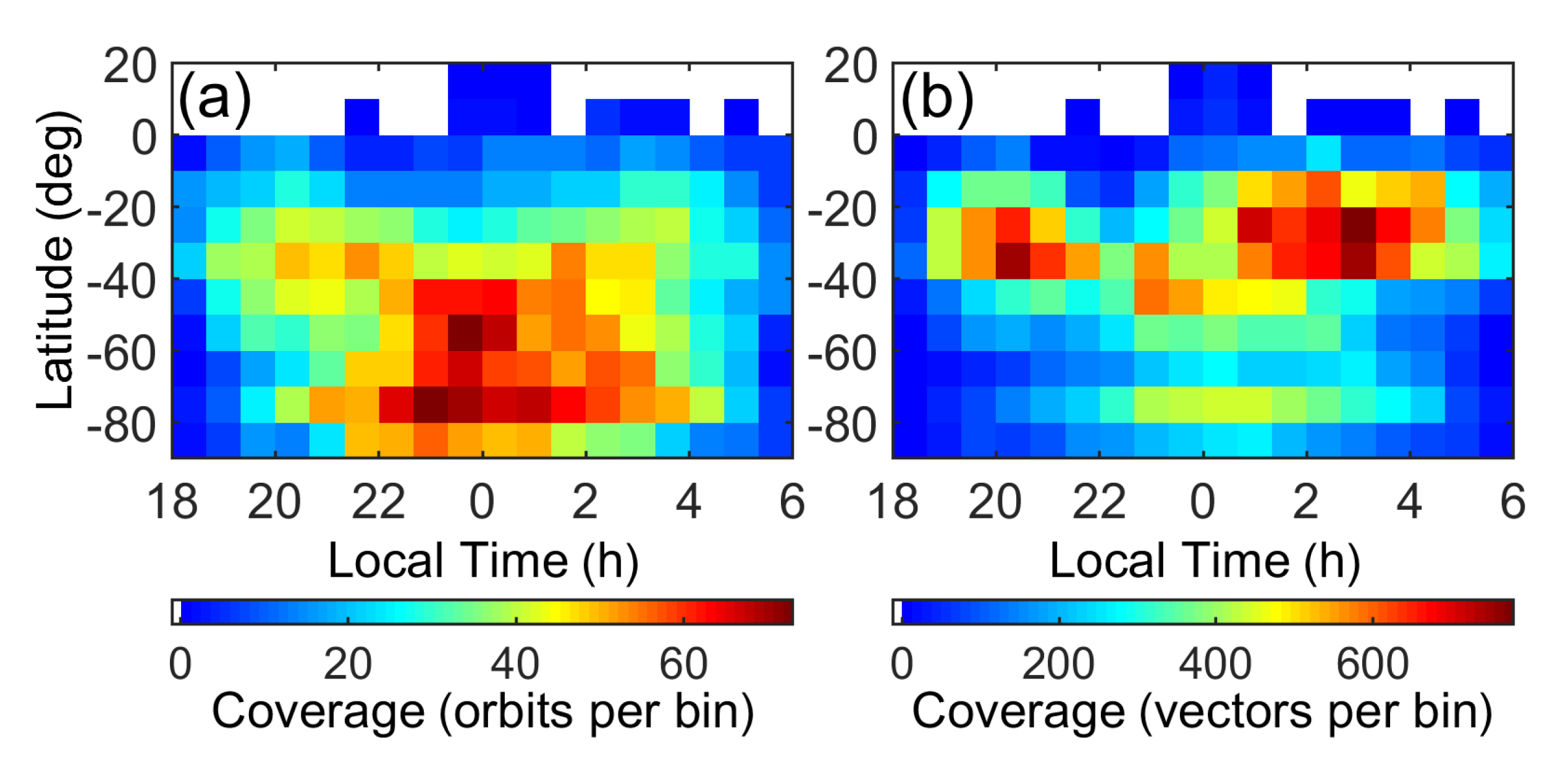

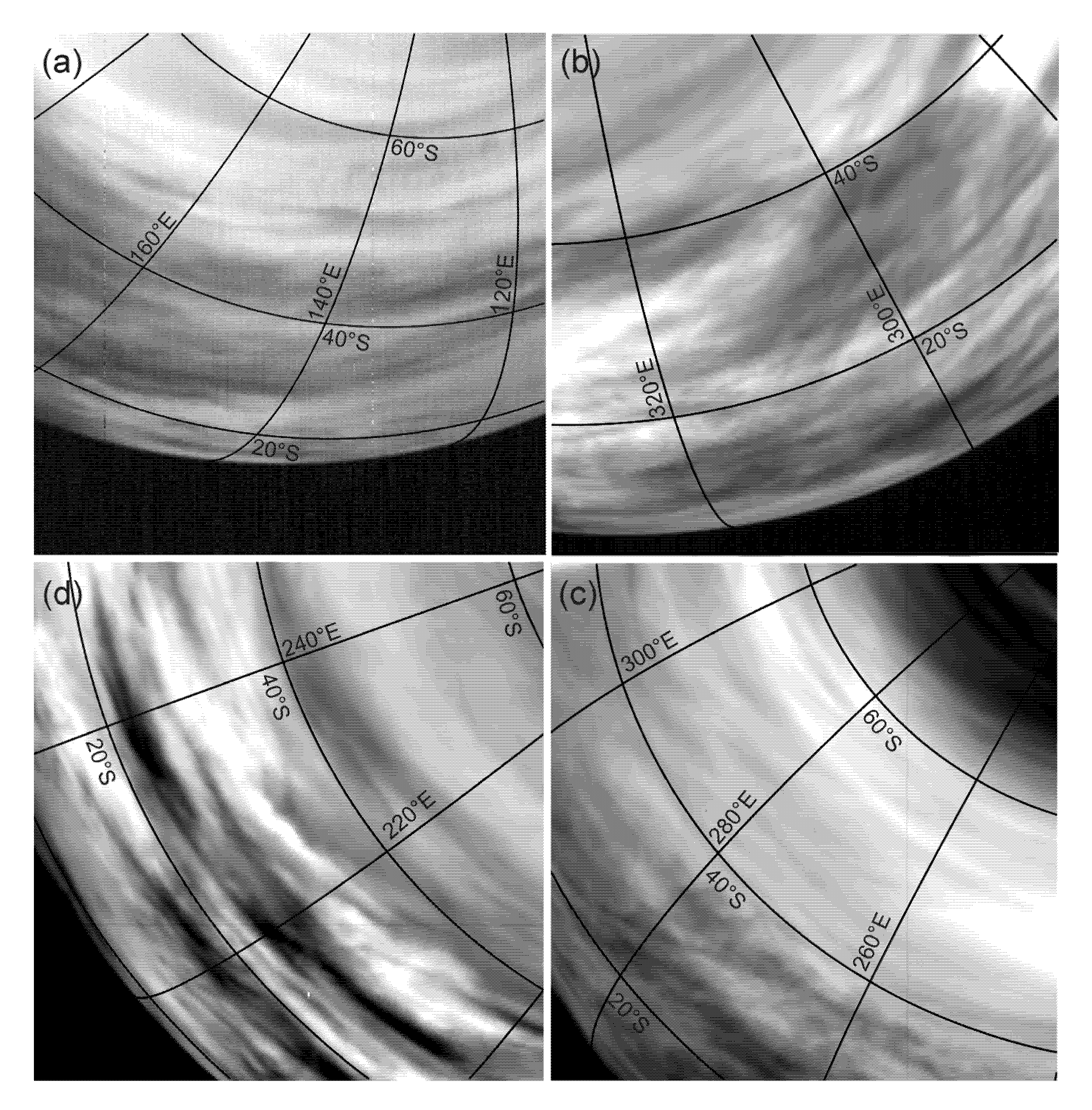
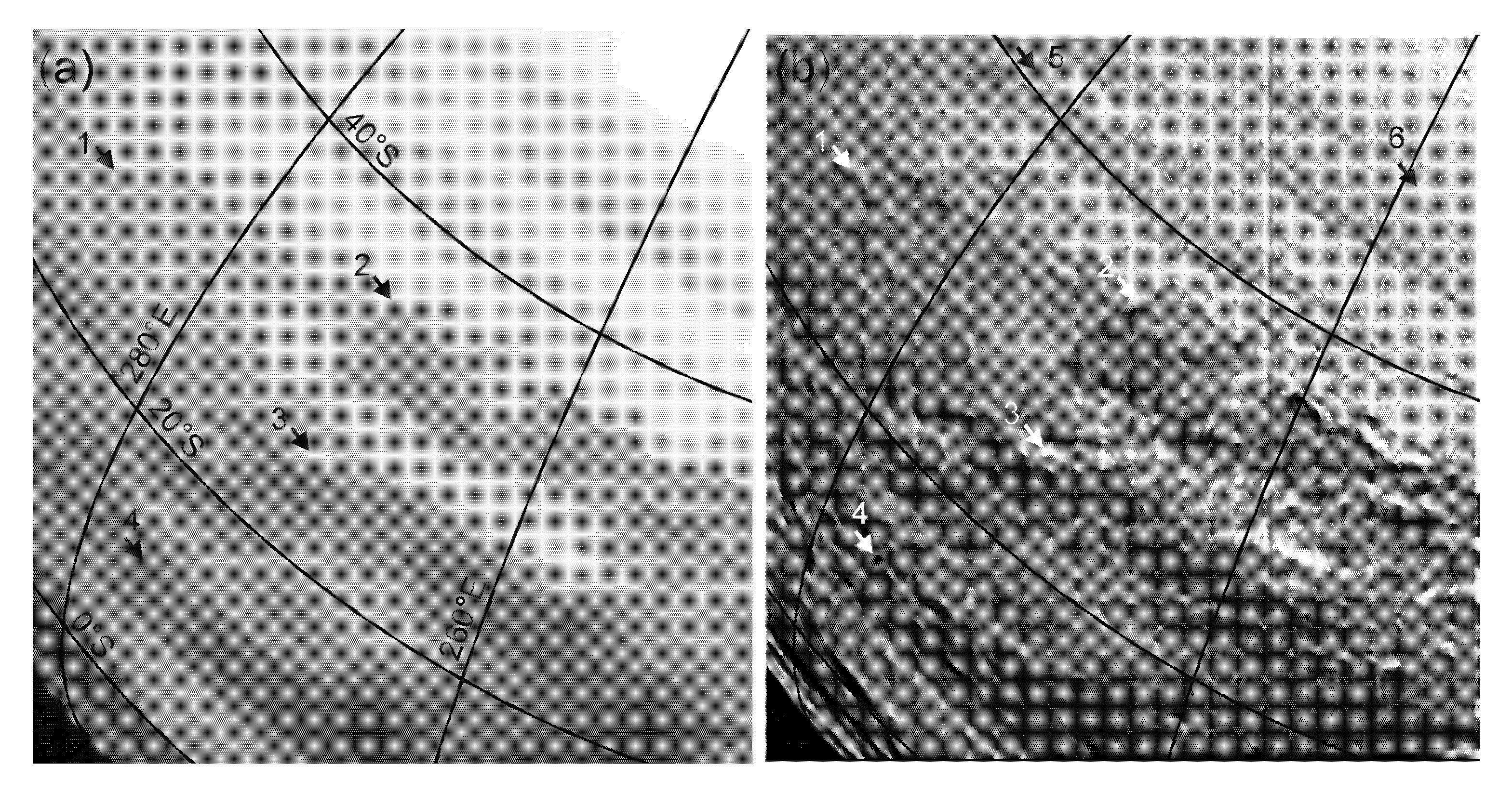
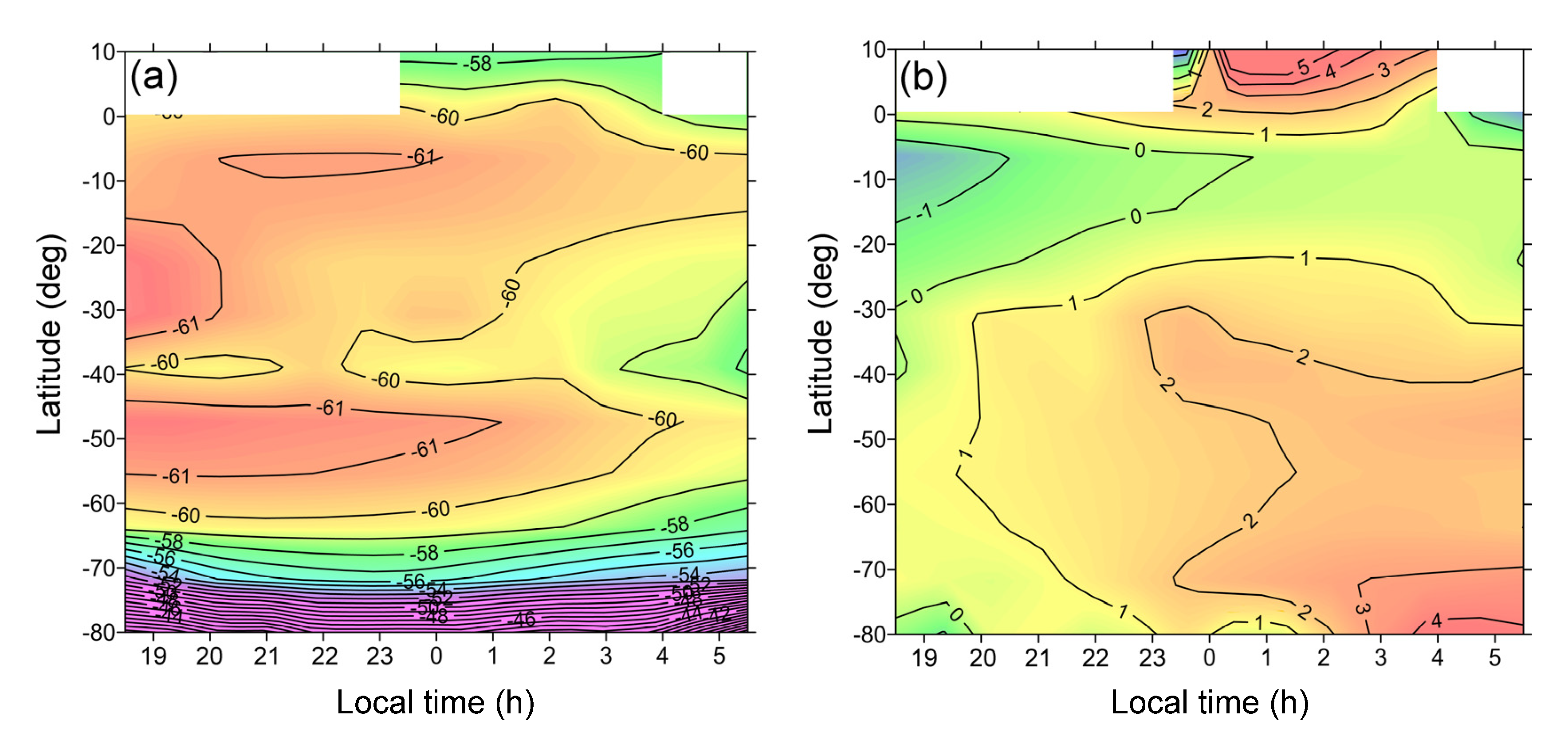
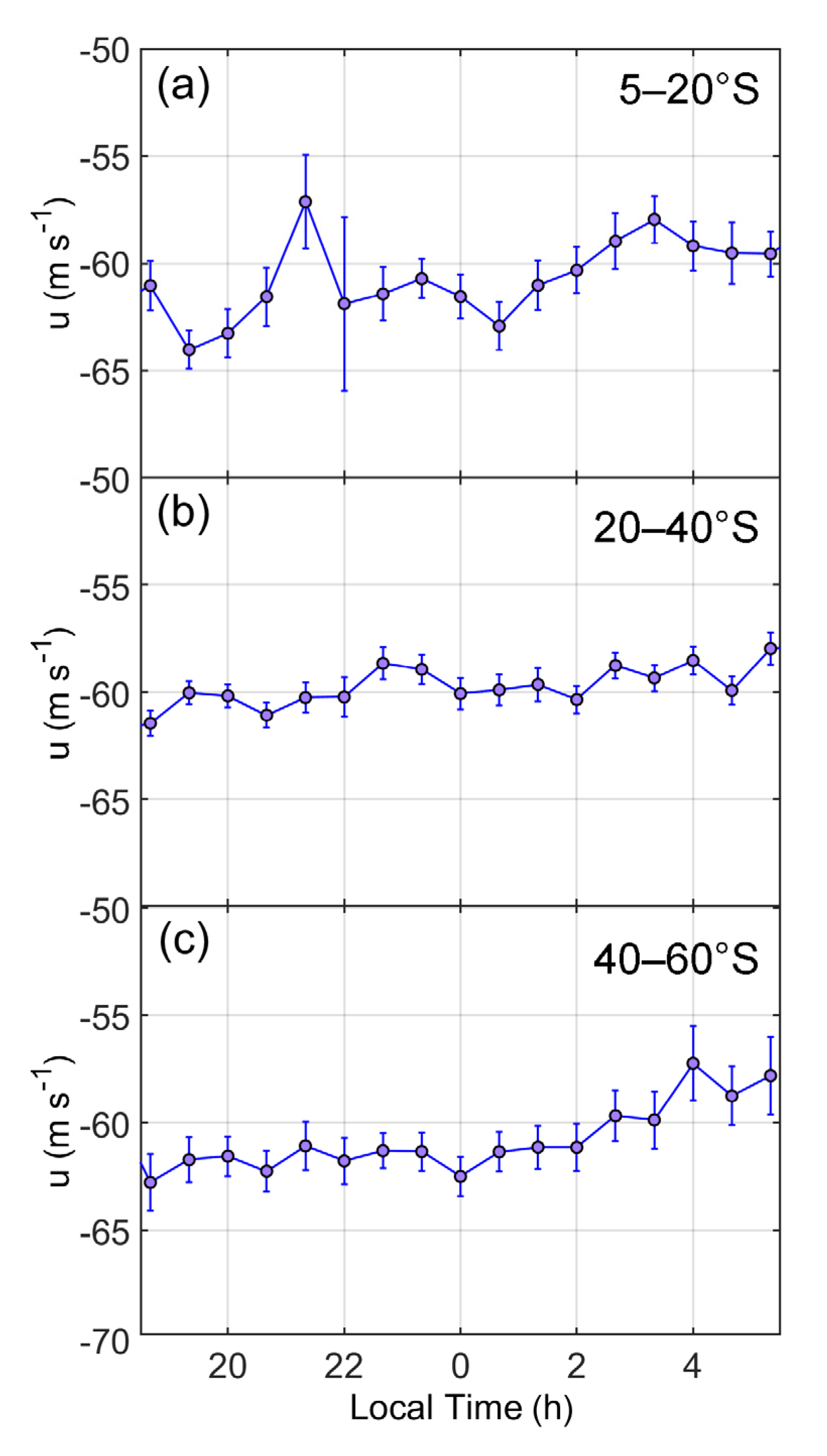
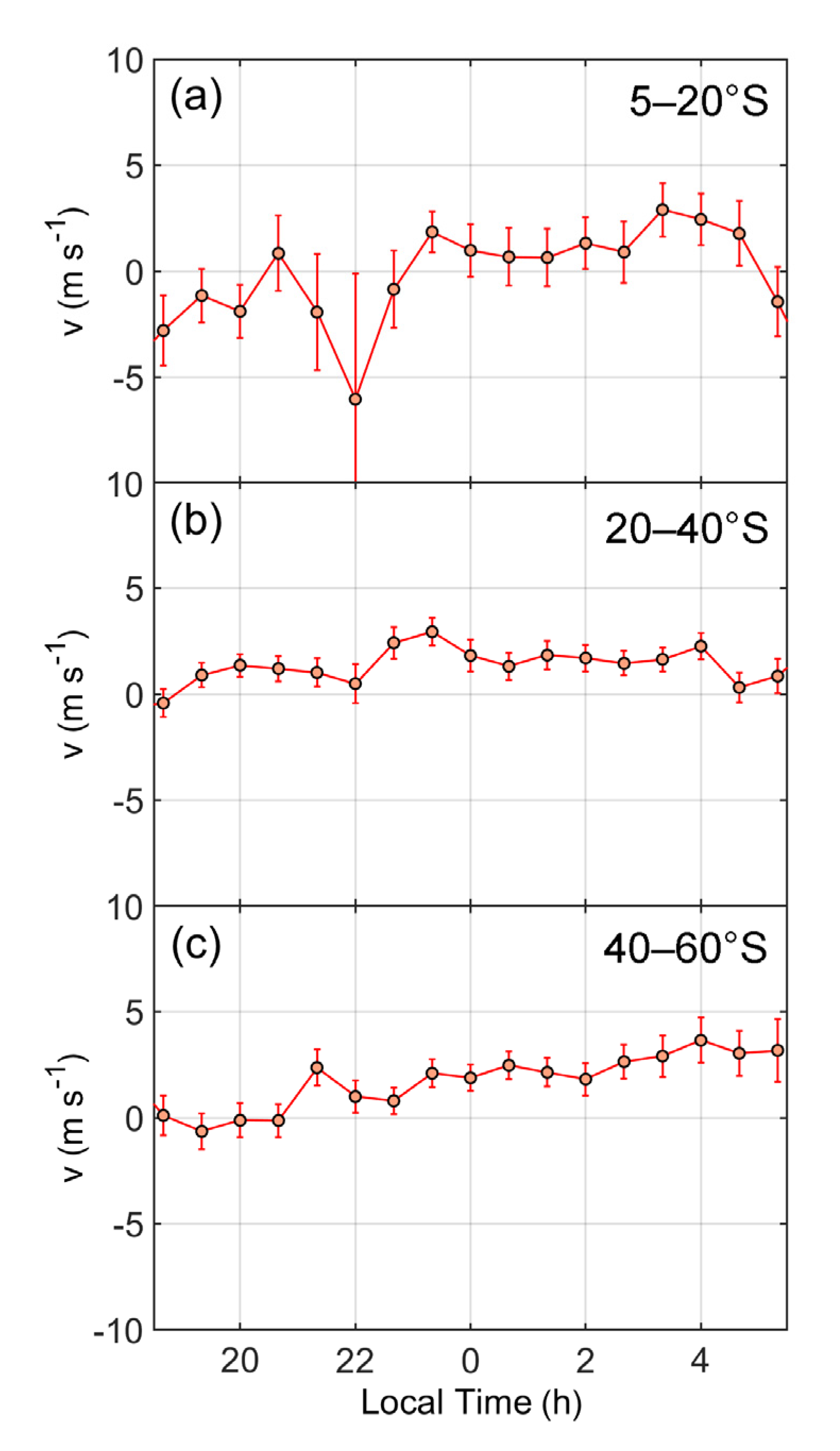
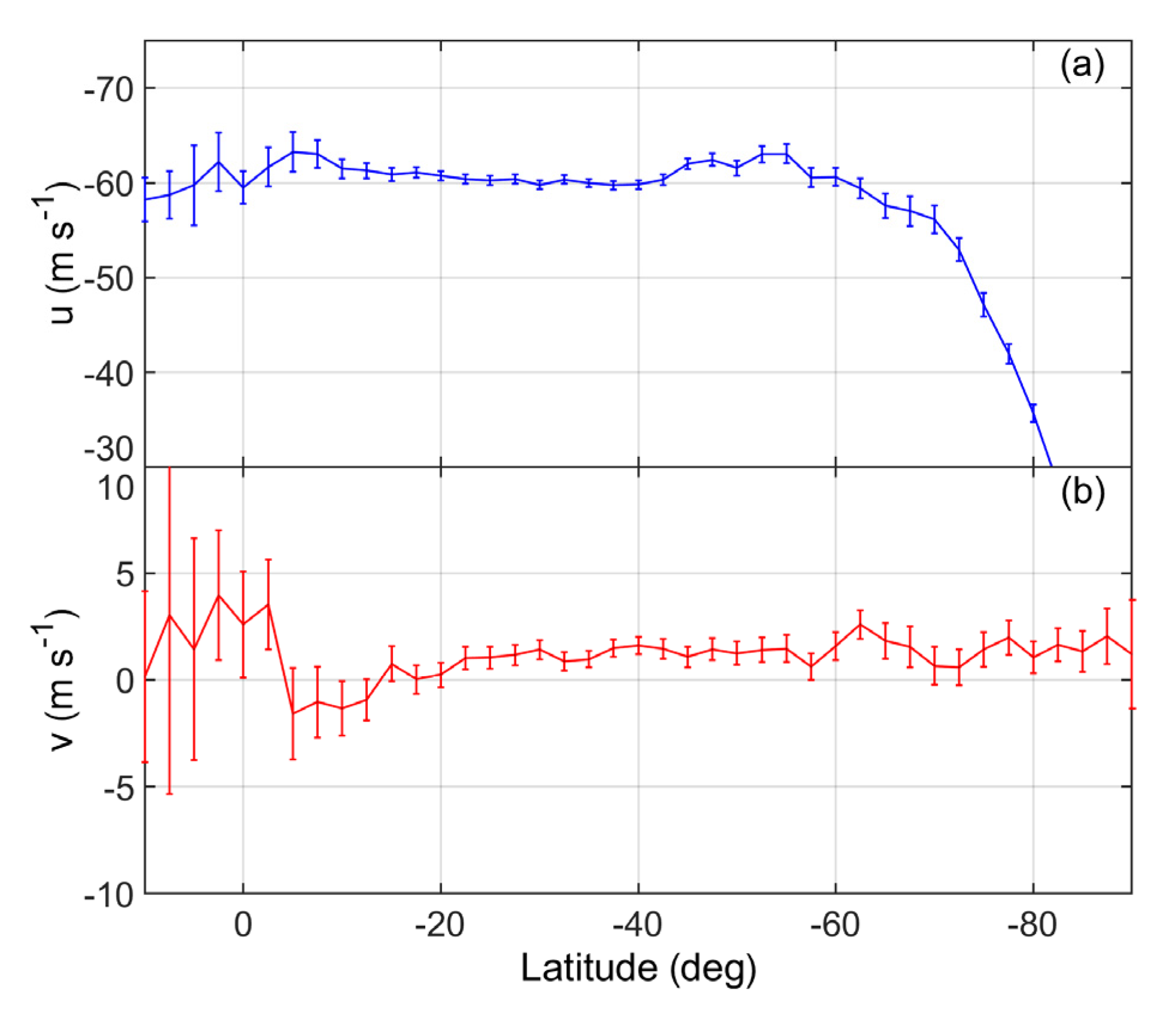
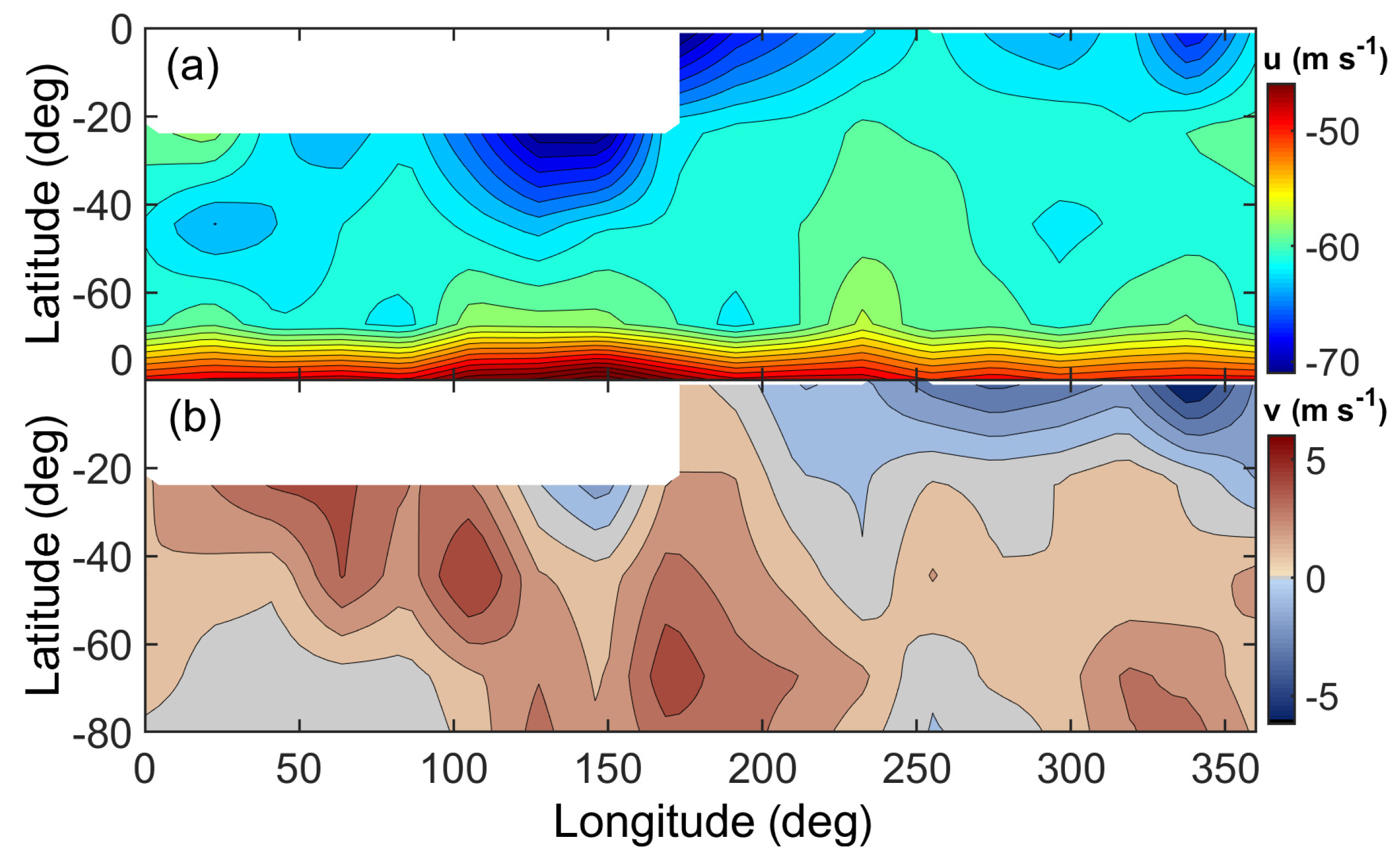
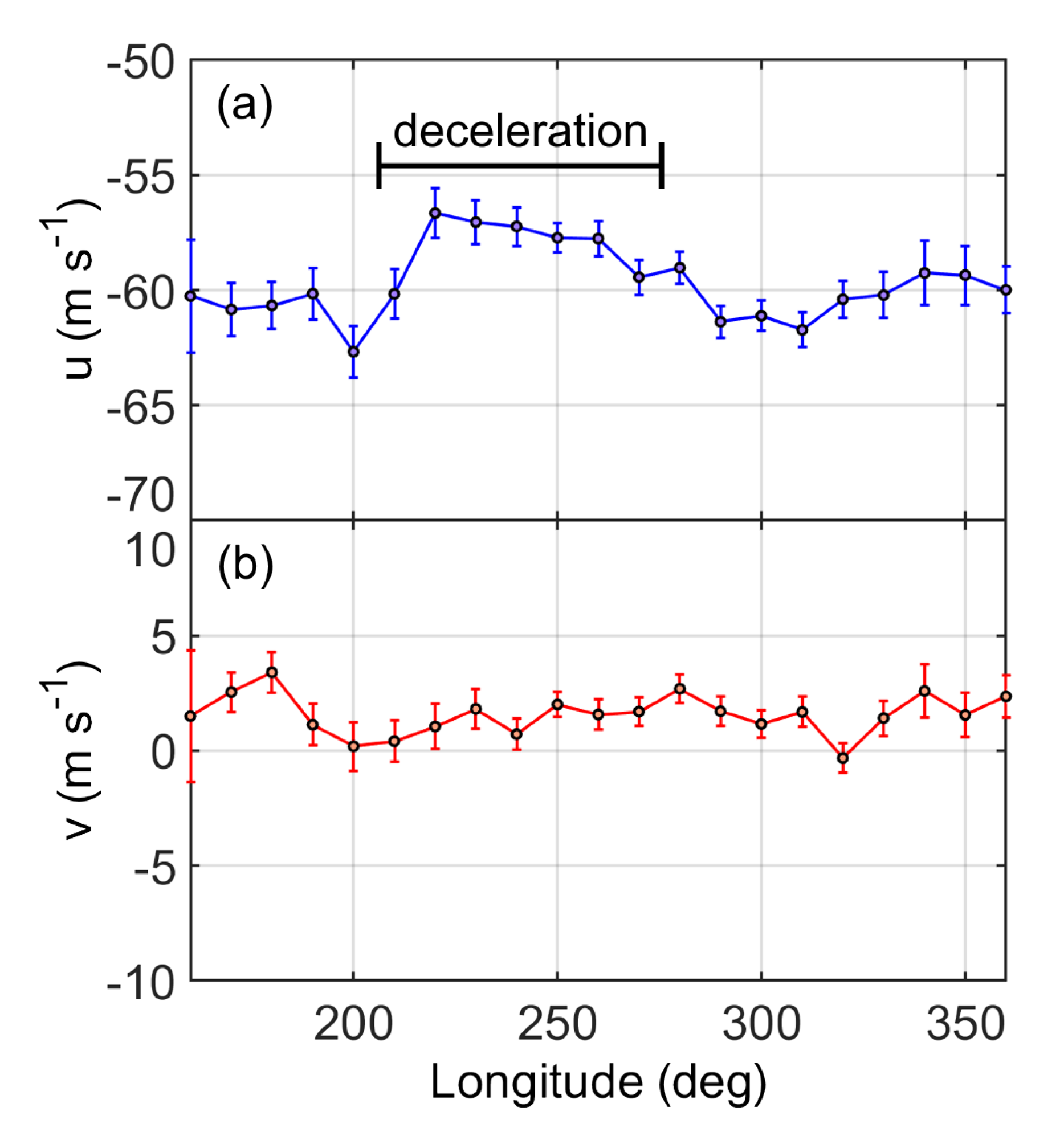

| Dataset | Begin/End | Orbit Numbers | Orbits | Vectors |
|---|---|---|---|---|
| I | 28 May 2006/5 October 2006 | 0038–0167 | 29 | 2605 |
| II | 4 December 2006/6 June 2007 | 0228–0411 | 97 | 23,904 |
| III | 18 July 2007/24 January 2008 | 0454–0644 | 44 | 12,774 |
| IV | 9 April 2008/27 October 2008 | 0720–0921 | 25 | 6007 |
| All | 28 May 2006/27 October 2008 | 0038–0921 | 195 | 44,480 |
Publisher’s Note: MDPI stays neutral with regard to jurisdictional claims in published maps and institutional affiliations. |
© 2021 by the authors. Licensee MDPI, Basel, Switzerland. This article is an open access article distributed under the terms and conditions of the Creative Commons Attribution (CC BY) license (http://creativecommons.org/licenses/by/4.0/).
Share and Cite
Gorinov, D.A.; Zasova, L.V.; Khatuntsev, I.V.; Patsaeva, M.V.; Turin, A.V. Winds in the Lower Cloud Level on the Nightside of Venus from VIRTIS-M (Venus Express) 1.74 μm Images. Atmosphere 2021, 12, 186. https://doi.org/10.3390/atmos12020186
Gorinov DA, Zasova LV, Khatuntsev IV, Patsaeva MV, Turin AV. Winds in the Lower Cloud Level on the Nightside of Venus from VIRTIS-M (Venus Express) 1.74 μm Images. Atmosphere. 2021; 12(2):186. https://doi.org/10.3390/atmos12020186
Chicago/Turabian StyleGorinov, Dmitry A., Ludmila V. Zasova, Igor V. Khatuntsev, Marina V. Patsaeva, and Alexander V. Turin. 2021. "Winds in the Lower Cloud Level on the Nightside of Venus from VIRTIS-M (Venus Express) 1.74 μm Images" Atmosphere 12, no. 2: 186. https://doi.org/10.3390/atmos12020186
APA StyleGorinov, D. A., Zasova, L. V., Khatuntsev, I. V., Patsaeva, M. V., & Turin, A. V. (2021). Winds in the Lower Cloud Level on the Nightside of Venus from VIRTIS-M (Venus Express) 1.74 μm Images. Atmosphere, 12(2), 186. https://doi.org/10.3390/atmos12020186







